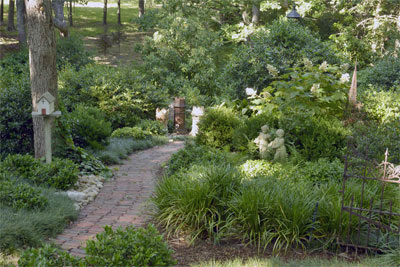The Sperry Backyard/Shade Central!

Bermudagrass requires 6 to 8 hours of hot, direct sunlight to thrive. St. Augustine and fescue require 4 to 6 hours. Zoysias are somewhere in-between, and buffalograss really needs full sunlight (and no bermuda nearby to invade it).
So, what’s a gardener to do if you don’t have that much sunlight? You might be able to remove one or two low-hanging branches and get enough light for the grass. Or, you might have one or two weak trees that are, to some degree, expendable. But, failing at that, it’s time to turn to shade-tolerant shrubs and groundcovers. This is part of our backyard, at the base of our native pecan forest, and I’ll share some of the plants that have worked best for me.
First of all, where I’d normally be walking on turfgrass, I’ve laid a walk of antique, hard-fired paving bricks removed from a local city during a storm sewer installation. They’re on a bed of packed sand. Also, I’ve laid several bark pathways by pouring out bags of pine bark mulch over bare ground and raking it smooth. Sure, it may wash during heavy rains, but at less than $3 per bag when I buy it in quantity, it’s no big deal.
Regular mondograss ("monkeygrass") is my groundcover of choice. I dig and divide established plants when I have new areas to cover. To the right, near the old wrought iron half-gate, I have the first cousin to mondograss, giant liriope. Farther down, in the bend in the walk at the base of the three antique English chimney pots, I’ve used a smaller planting of dwarf mondograss, and elsewhere, not visible from this angle, I’ve used purple wintercreeper euonymus and Asian jasmine groundcovers. I prefer mondograss to them, however, since it’s much easier to remove fallen pecan leaves in autumn when the groundcover bed has no runners.
Hollies that are visible in general order, left to right: Carissa, Willowleaf, Robin, dwarf yaupon, Nellie R. Stevens, Lusterleaf, dwarf Chinese, dwarf Burford and regular yaupon. (I guess I kinda like hollies.) You also see Japanese boxwoods behind the statues and one Oakleaf hydrangea behind the boxwoods. There is one large Chinese photinia (much superior to the problem-prone redtip photinias) directly above the chimney pots. I know to look for nandinas of three different types and aspidistra (cast iron plant), but it’s hard to point them out in this image.
I don’t try a lot of flowers in the shade, but ajuga, oxalis, violets, Texas Gold columbines, summer phlox and hellebores, among others, would do well. I prefer to get my color via the hardscaping elements such as the brick walk, church art piece and colorful globes I’ve used off-camera to the left.
So, as I always try to say with encouragement, I’ve always found that shade isn’t a challenge – it’s a new opportunity. I hope this is of help.
